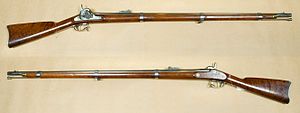Springfield Model 1855
| Model 1855 Rifle-Musket | |
|---|---|

Springfield Armory Model 1855 Musket
|
|
| Type | Rifled musket |
| Place of origin | United States |
| Service history | |
| Used by | United States, Confederate States of America |
| Wars | Yakima War, American Civil War |
| Production history | |
| Designed | 1856 |
| Manufacturer | Springfield Armory |
| Produced | 1856-1860 |
| No. built | 60,000 |
| Specifications | |
| Weight | 9 pounds (4.1 kg) |
| Length | 56 in (1,400 mm) |
| Barrel length | 40 in (1,000 mm) |
|
|
|
| Cartridge | .58 minie ball |
| Caliber | 0.58 inches (15 mm) |
| Action | Maynard tape primer |
| Rate of fire | 2-3 rounds per minute |
| Muzzle velocity | 1,000 to 1,200 feet per second (300 to 370 m/s) |
| Effective firing range | 200 to 300 yards (180 to 270 m) |
| Maximum firing range | 800 to 1,000 yards (730 to 910 m) |
| Feed system | Muzzle-loaded |
The Model 1855 Springfield was a rifled musket widely used in the American civil war. It exploited the advantages of the new conical Minié ball, which could be deadly at over 1000 yards. About 60,000 of these rifles were made, and it was a standard infantry weapon for Union and Confederates alike, until the Model 1861 supplanted it, obviating the use of the insufficiently waterproof Maynard tape primer.
The Model 1855 Springfield was a rifled musket used in the mid 19th century. It was produced by the Springfield Armory in Massachusetts and at the Harpers Ferry Arsenal in Virginia.
Earlier muskets had mostly been smooth bore flintlocks. In the 1840s, the unreliable flintlocks had been replaced by much more reliable and weather resistant percussion cap systems. The smooth barrel and inaccurate round ball were also being replaced by rifled barrels and the newly invented Minié ball. This increased the typical effective range of a musket from about 50 yards to several hundred yards. The Model 1855 had an effective range of 500 yards and was deadly to over 1,000 yards.
The barrel on the Model 1855 was .58 caliber, which was smaller than previous muskets. The Model 1816 Musket and all of its derivatives up through the Model 1842 Musket had been .69 caliber, but tests conducted by the U.S. Army showed that the smaller .58 caliber was more accurate when used with a minie ball.
The Model 1855 also used the Maynard tape primer, which was an attempt at improving the percussion cap system that had been previously developed. Instead of using individual caps which had to be placed for every shot, the Maynard system used a tape which was automatically fed every time the hammer was cocked, similar to the way a modern child's cap gun works. While the powder and Minié ball still had to be loaded conventionally, the tape system was designed to automate the placing of the percussion cap and therefore speed up the overall rate of fire of the weapon. The Maynard tape system gave the Model 1855 a unique hump under the musket's hammer. The weapon could also be primed in the usual way with standard percussion caps if the tape was unavailable.
...
Wikipedia
